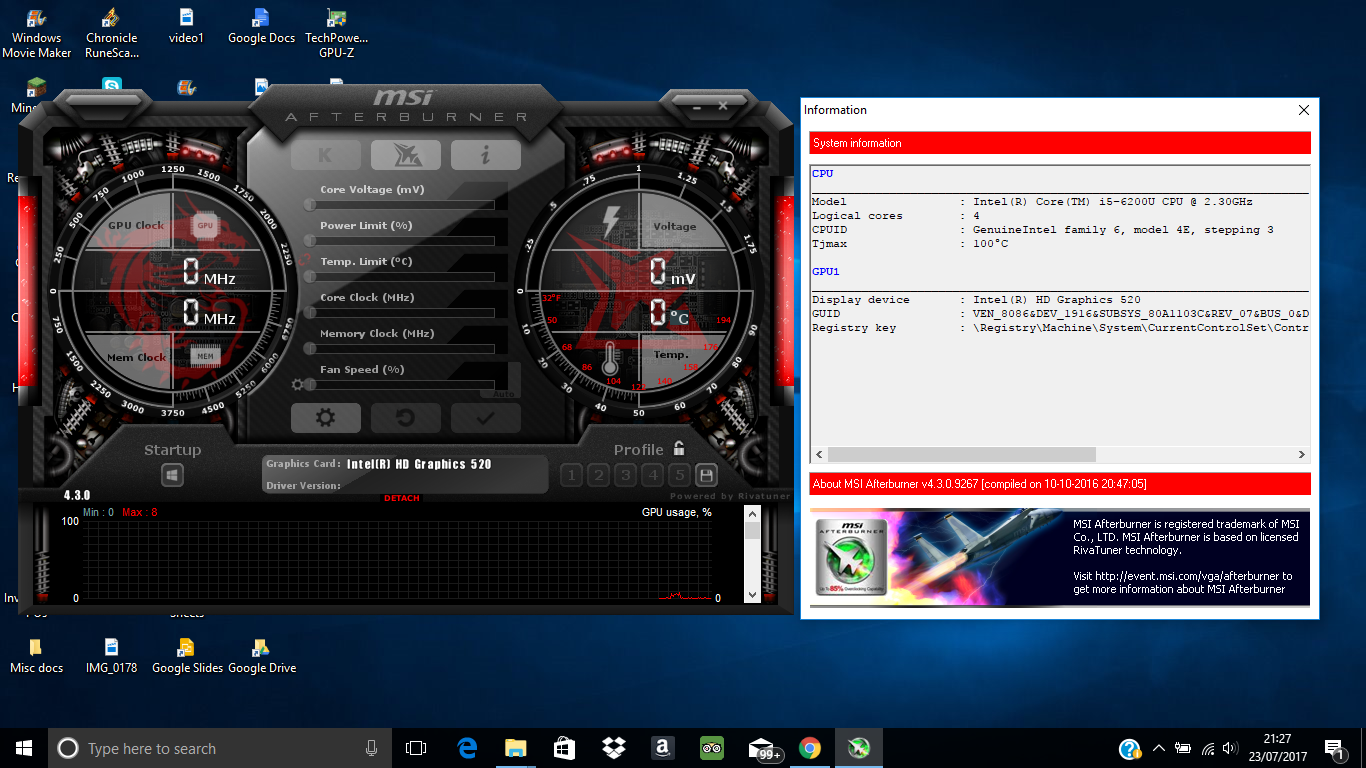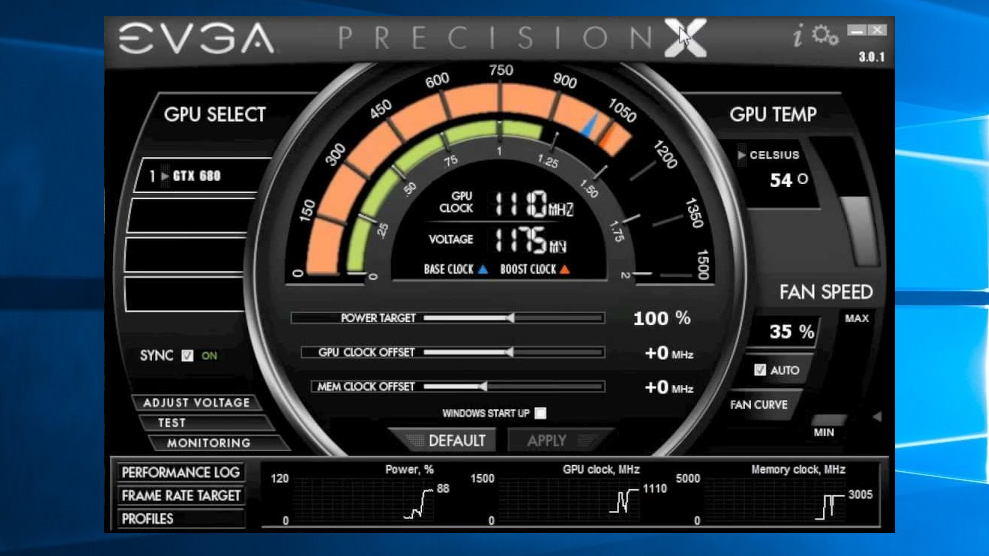It’s all well and good splashing out for a pre-built PC or putting together a bespoke tower yourself, but what’s the point of sinking all that money into it if you’re not getting the very best performance out of each component? That’s where overclocking comes in.
We’ve gathered together the best free pieces of overclocking programs available right now, from mainstream utilities that anyone can pick up and use to complicated tools that enable you to tweak even the smallest of elements in pursuit of even more gaming performance.


1. MSI Afterburner
Intimidated by overclocking? MSI Afterburner makes it easy for even complete beginners to wring extra power from their hardware
One of the oldest overclocking tools out, but still one of the best, MSI Afterburner has become a mainstay on the PC overclock scene. So why is it still so popular?
Well, for a start it’s very easy to use, making it ideal for newbies and those with an intermediate level of knowledge to push your graphics to their designed limit. Also, unlike EVGA PrecisionX (mentioned below), it supports both Nvidia and AMD processors.
The current version of MSI Afterburner includes a still decent number of utilities, including GPU/shader/memory clock adjustment, the power to adjust advanced fan speed, and the ability to tweak GPU voltage control.
We also like the bespoke hardware monitor included as part of the interface, which effectively tracks the performance of your rig and shows frame rates, etc while you’re playing a game.
Sure, it’s not the most comprehensive of packages, and certainly won’t appeal to the hardcore among us, but it’s still a robust suite that will help transform your games if you’re relatively new to the scene.


2. AMD Overdrive
If you have an AMD GPU, this is the only overclocking software you need
Unlike MSI Afterburner, AMD Overdrive only supports AMD's own branded GPUs, but it still manages to offer one of the most impressive ways to get your PC running at an invigorated pace. As long as your CPU is of AMD origin (including its chipset), you can start pushing those components like they’ve never been tested before. Best of all, the attractive interface provides convenient access to an impressively in-depth set of tools to make this ideal for both relative newcomers and seasoned overclockers.
So what does this brilliant little free overclocking tool offer? For a start, AMD Overdrive enables you to change the clock speed of your RAM and adjust the overall speed of your fans (an incredibly useful utility, especially if you’re currently having overheating issues).
The built in status monitor lets you see the state of your processor in real time as you overclock it to the hilt, and with streamlined interface (one that’s markedly improved over the years), you can easily and confidently tweak the voltage or clock speeds by simply moving a slider.
Okay, there’s a little more to it than that, but we like how cleanly it can distill its utilities down to simple actions.


3. EVGA Precision X
Free, convenient overclocking software for Nvidia graphics card owners, with support for up to 10 custom user profiles
Easily one of the most popular overclocking tools on the market today, EVGA PrecisionX has become a must for gamers looking to give their rig or gaming laptop a decent push in the hardware performance stakes.
Unfortunately, EVGA PrecisionX only works with Nvidia graphics cards (sorry, AMD users) so you’ll need to have something like a GeForce GTX TITAN, 900, 700 or 600 installed.
The latest version supports Microsoft DirectX 12 API, as well as enabling you to change your GPU’s clock offset and its memory clock offset. As if that wasn’t good enough, EVGA PrecisionX also presents you with the power to overclock your refresh rate and establish up to 10 individual overclocking setups. You can even seamlessly switch between them at will!
This being a free overclocking tool aimed at gamers who want better performance with the minimum of hassle, the freeware offers an easily navigable interface that won’t drown you in too many options or utilities.
It might not be as comprehensive as some of the more advanced tools out there, but if you’re looking to squeeze out better clock speeds overall, EVGA PrecisionX is an ideal addition to your machine.


4. CPU-Z and GPU-Z
Two free programs that will give you an in-depth look at your hardware, helping you see where there's room for improvement
Not all free overclocking tools give you the kind of data you really need to see where you machine can be tweaked or adjusted. That’s where tools like CPU-Z and GPU-Z come in, offering an in-depth look into exactly how your PC or laptop is performing.
CPU-Z enables you to track processor name and number details, determine codenames, identify processes, packages, cache levels and more. It can test the performance of your mainboard and chipset, as well as instantly bringing up memory types, sizes, timings and module specifications (SPD). It can even offer real-time measurements of each core's internal frequency and memory frequency.
Then there’s GPU-Z, which supports Nvidia, AMD, ATI and Intel GPUs (so you’ll definitely have a card that’s compatible). The free tool displays adapter, GPU and display information, and provides all the information you’ll need for overclock, default clocks and 3D clock shenanigans.
Both GPU-Z and CPU-Z work brilliantly alongside all of the overclocking tools in this list, so grab them both and take a peek deep inside your PC.


5. SetFSB
One for the experts, SetFSB lets you tinker with your PC's front side bus
We’ve shown you some of the most popular tools and utilities in the world of overclocking, but what if you’re a seasoned PC builder who wants to squeeze every ounce of juice your machine has to offer? Sounds like you need something in-depth and comprehensive that’s been designed with overclocking pros in mind – say hello to the brilliant little tool that is SetFSB.
Unlike some other overclocking tools, SetFSB is all about making adjustments to your system's front-side bus (FSB), which connects the CPU to the main memory. Its speed is measured in MHz and can vary from 60 to 400 (it can go higher if you’re lucky/slightly mad), so the higher the speed, the better the performance. Think of it as plugging yourself directly into the Matrix.
One quick word of warning, though. SetFSB is not for the faint of heart and should only really be used if you’re an experienced PC tinkerer and overclock pro. You’ll need a strong knowledge of the limits of your motherboard and CPU before tinkering with its settings, otherwise you could end up cooking your machine due to the unbridled precision at your fingertips.
- For a safer way to give your PC a boost, try some free optimization software
from TechRadar - All the latest technology news http://bit.ly/2gWgqve
via IFTTT


0 comments:
Post a Comment